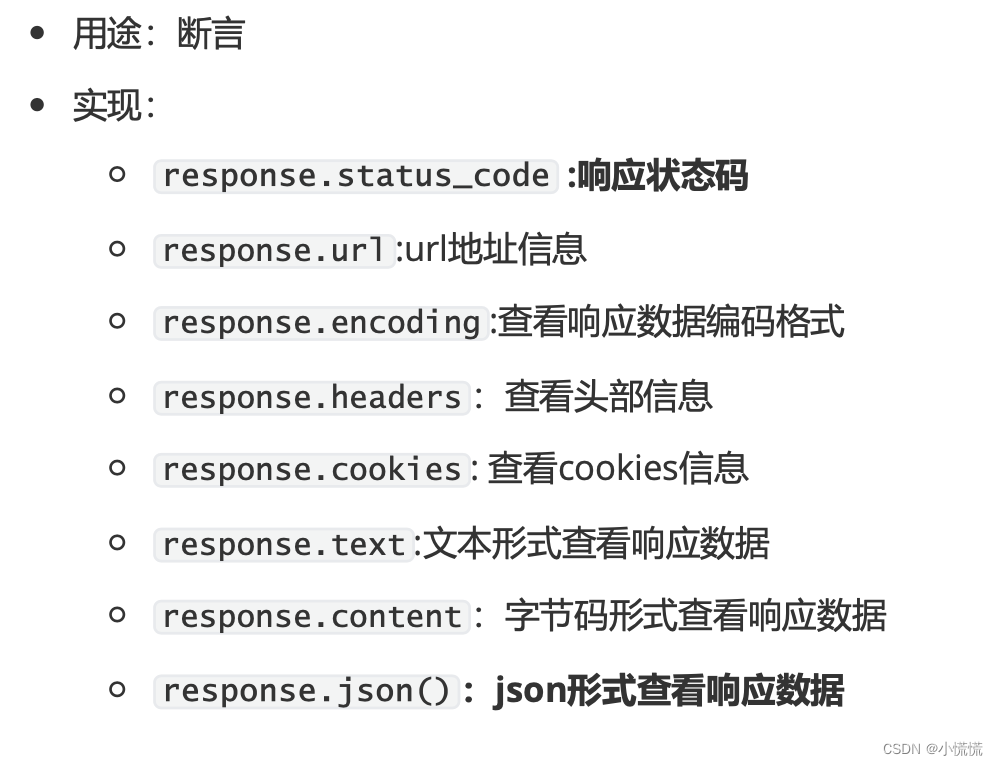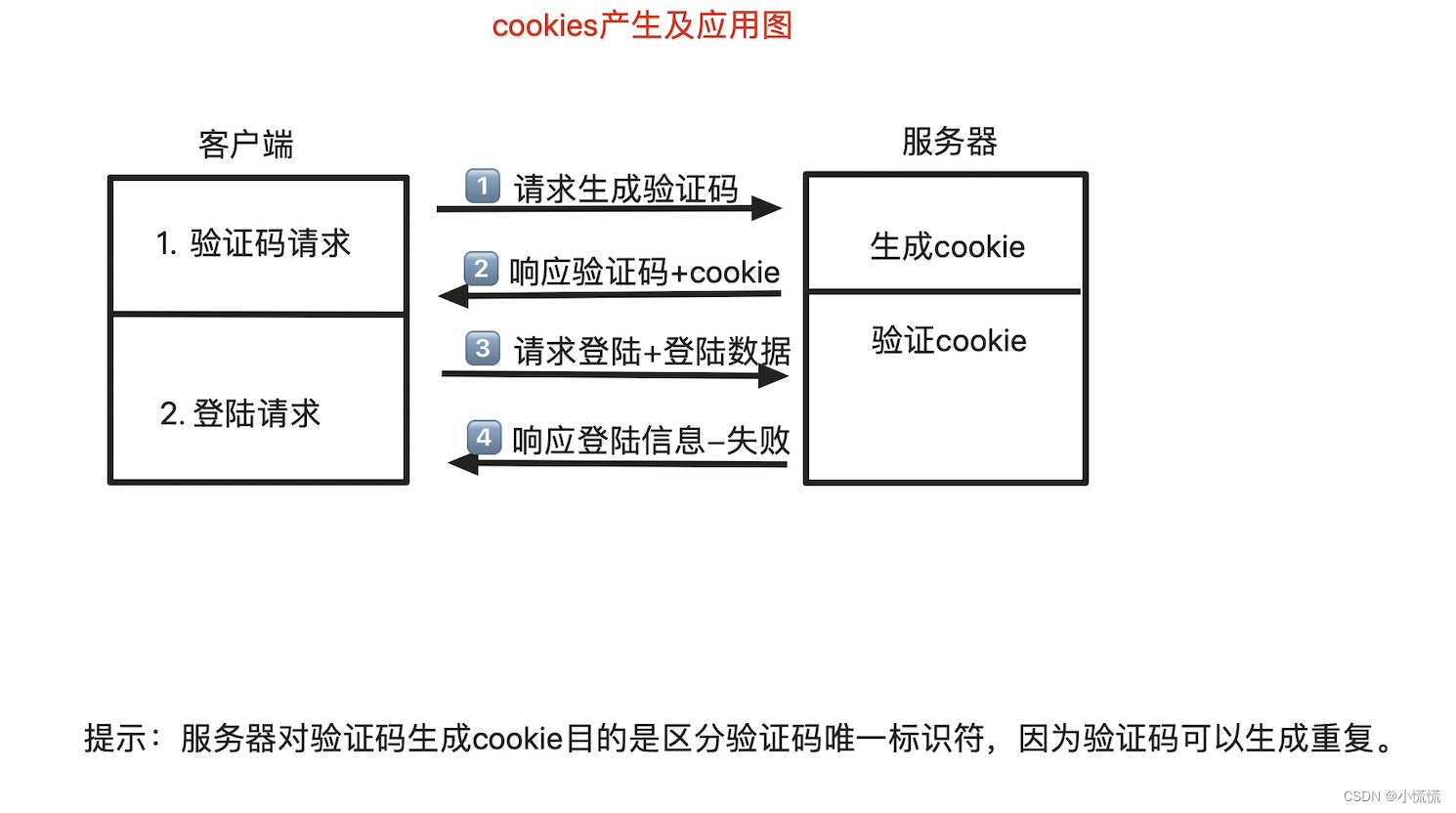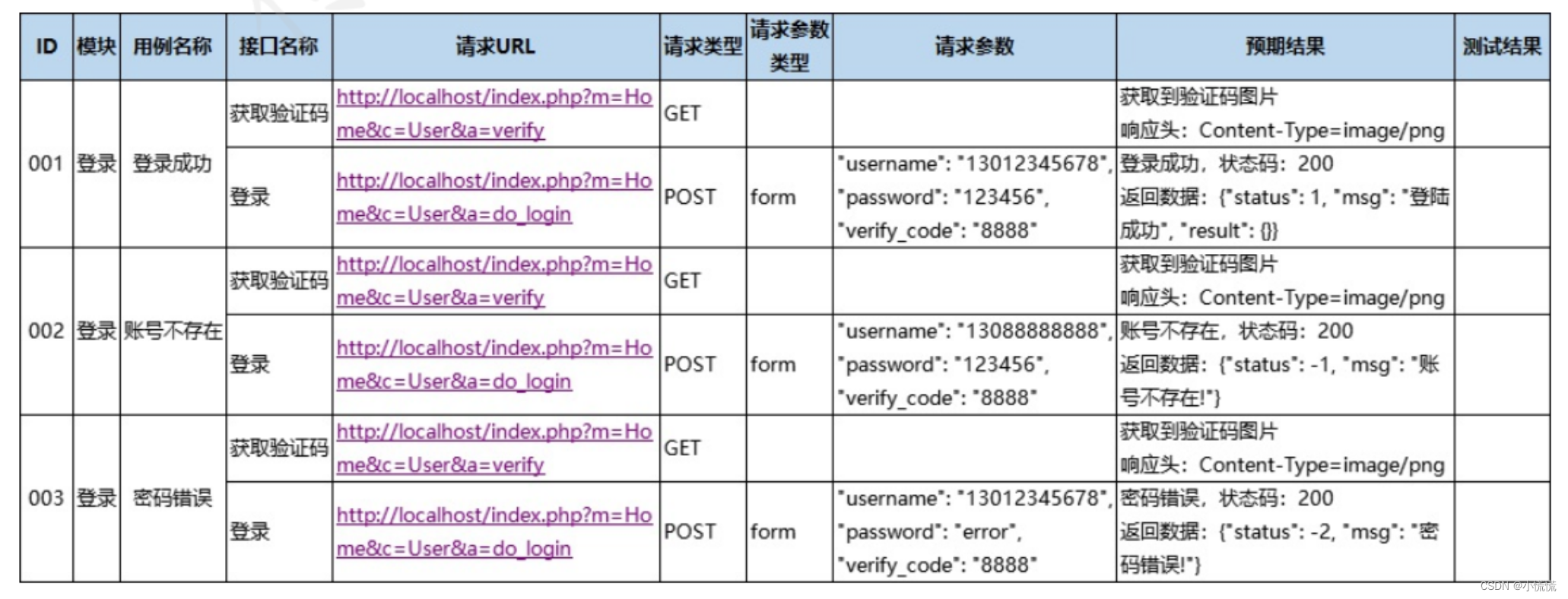【接口测试】Day6-使用requests库
目录
今日目标
requests
- 使用requests库传递URL参数、设置请求头与请求体
- 使用requests库获取响应数据
- 使用requests库发送不同类型的请求
- requests库session操作
unittest
- requests库集成unittest
一、requests库
1 、介绍和安装
介绍:基于python语言开发的一个开源的库,能够完全满足基于HTTP协议的接口测试。
- 安装: pip3 install requests
-
% pip3 install requests Defaulting to user installation because normal site-packages is not writeable Collecting requests Downloading requests-2.27.1-py2.py3-none-any.whl (63 kB) ━━━━━━━━━━━━━━━━━━━━━━━━━━━━━━━━━━━━━━━━ 63.1/63.1 kB 400.2 kB/s eta 0:00:00 Collecting urllib3<1.27,>=1.21.1 Downloading urllib3-1.26.9-py2.py3-none-any.whl (138 kB) ━━━━━━━━━━━━━━━━━━━━━━━━━━━━━━━━━━━━━━━━ 139.0/139.0 kB 582.2 kB/s eta 0:00:00 Collecting idna<4,>=2.5 Downloading idna-3.3-py3-none-any.whl (61 kB) ━━━━━━━━━━━━━━━━━━━━━━━━━━━━━━━━━━━━━━━━ 61.2/61.2 kB 273.1 kB/s eta 0:00:00 Collecting charset-normalizer~=2.0.0 Downloading charset_normalizer-2.0.12-py3-none-any.whl (39 kB) Collecting certifi>=2017.4.17 Downloading certifi-2022.5.18.1-py3-none-any.whl (155 kB) ━━━━━━━━━━━━━━━━━━━━━━━━━━━━━━━━━━━━━━━━ 155.2/155.2 kB 368.6 kB/s eta 0:00:00 Installing collected packages: urllib3, idna, charset-normalizer, certifi, requests WARNING: The script normalizer is installed in '/Users/zxf/Library/Python/3.8/bin' which is not on PATH. Consider adding this directory to PATH or, if you prefer to suppress this warning, use --no-warn-script-location. Successfully installed certifi-2022.5.18.1 charset-normalizer-2.0.12 idna-3.3 requests-2.27.1 urllib3-1.26.9 - 验证:pip3 show requests
-
% pip3 show requests Name: requests Version: 2.27.1 Summary: Python HTTP for Humans. Home-page: https://requests.readthedocs.io Author: Kenneth Reitz Author-email: me@kennethreitz.org License: Apache 2.0 Location: /Users/zxf/Library/Python/3.8/lib/python/site-packages Requires: certifi, charset-normalizer, idna, urllib3 Required-by:
2 发送get请求
# 导包
import requests
# 发送请求
response = requests.get("http://www.baidu.com")
# 查看响应
# 查看响应数据编码格式
print("原始的数据编码为:", response.encoding)
print("设置前响应数据:", response.text)
# 设置响应数据编码格式
response.encoding = "utf-8"
print("设置编码后数据编码为:", response.encoding)
print("设置后响应数据:", response.text)- 解决响应数据乱码问题
- 获取当前编码格式: 响应.encoding
- 设置新的编码规范: 响应.encoding="utf-8"

- 运行结果:

3 发送post请求
response = requests.post(url, data=None, json=None)
"""
:param url: 请求的URL
:param data: (可选) 要发送到请求体中的字典、元组、字节或文件对象
:param json: (可选) 要发送到请求体中的JSON数据
"""说明:
- data: 参数接收form表单数据,后台会自动附加form表单请求信息头(data数据格式为字典)
- json:参数接收json数据,后台会自动附加json表单请求信息头(headers = {"Content-Type":"application/json"})
3.1 提交form表单
"""
1. 请求TPshop项目的登录接口,
请求数据(username: username, password: 123456, verify_code: 1234)
2. 登录接口URL:http://localhost/index.php?m=Home&c=User&a=do_login
"""
# 导包
import requests
# 发请求
login_url = "http://localhost/index.php?m=Home&c=User&a=do_login"
login_data = {
"username": "username",
"password": "123456",
"verify_code": "8888"
}
response = requests.post(url=login_url, data=login_data)
# 看响应
print(response.json())
到tpshop官网下载页面 下载看安装视频教程,或者自己搭的web也行
3.2 提交json数据
# 导包
import requests
# 发送请求
login_url = "http://IP:端口/api/sys/login"
login_data = {
"mobile": "13000000000",
"password": "123456"
}
response = requests.post(url=login_url, json=login_data)
# 查看响应
print(response.json())4 其他请求方式(了解)
- put:修改资源
- delete:删除资源
- head:响应数据中只包含请求头,前提是项目中已实现该功能
- options:查看接口支持的请求方法,前提是项目中已实现该功能
5 传递URL参数
- 需求:
1. 访问TPshop搜索商品的接口,通过查询字符串的方式传递搜索的关键字 iPhone ,并查看响应数据
2. 请求路径格式为: http://localhost/Home/Goods/search.html?q=iPhone
- 代码实现:
# 导包
import requests
# 发送请求
# 直接通过url传递参数
# response = requests.get(" http://localhost/Home/Goods/search.html?q=iphone")
# 通过params传递参数:
# (1)字符串
urlA = "http://localhost/Home/Goods/search.html"
stringA = "q=iphone"
response = requests.get(url=urlA, params=stringA)
# (2)字典
dictA = {
"q": "iphone"
}
response = requests.get(url=urlA, params=dictA)
# 查看响应
print(response.text)6 响应内容解析

案例1
1). 访问百度首页的接口`http://www.baidu.com`,获取以下响应数据
2). 获取响应状态码
3). 获取请求URL
4). 获取响应字符编码5). 获取响应头数据
6). 获取响应的cookie数据 7). 获取文本形式的响应内容 8). 获取字节形式的响应内容
案例1-代码
import requests
# 1). 访问百度首页的接口`http://www.baidu.com`,获取以下响应数据
response = requests.get("http://www.baidu.com")
# 2). 获取响应状态码
print("响应状态码:", response.status_code)
# 3). 获取请求URL
print("URL:", response.url)
# 4). 获取响应字符编码
print("编码格式为:", response.encoding)
# 5). 获取响应头数据
print("响应头信息:", response.headers)
print("Content-Type:", response.headers.get("Content-Type"))
# 6). 获取响应的cookie数据
print("cookies:", response.cookies)
print("提取指定的cookie:", response.cookies.get("BDORZ"))
# 7). 获取文本形式的响应内容
print("文本形式显示响应内容:", response.text)
# 8). 获取字节形式的响应内容
print("获取字节形式的响应内容:", response.content)
print("获取字节形式的响应内容:", response.content.decode("utf-8"))案例2
1). 访问查询天气信息的接口,并获取JSON响应数据
2). 接口地址:http://www.weather.com.cn/data/sk/101010100.html
案例2-代码
import requests
# 1). 访问查询天气信息的接口,并获取JSON响应数据
# 2). 接口地址:http://www.weather.com.cn/data/sk/101010100.html
response = requests.get("http://www.weather.com.cn/data/sk/101010100.html")
# 查看响应
print(response.json())7 设置请求头
- 使用方法: headers={"Content-Type":"application/json"}
案例:
"""
1. 请求IHRM项目的登录接口,URL: http://ip:端口/api/sys/login
2. 请求头: Content-Type: application/json
3. 请求体: {"mobile":"13800000002", "password":"123456"}
"""
import requests
login_url = "http://ip:端口/api/sys/login"
login_header = {
"Content-Type": "application/json"
}
login_data ={
"mobile": "13800000002",
"password": "123456"
}
# 发送请求
response = requests.post(url=login_url, json=login_data, headers=login_header)
# 查看响应
print(response.json())8 设置cookie(了解)

使用:
- 案例:解决tpshop登录验证码问题
1. 使用requests库调用TPshop登录功能的相关接口,完成登录操作
2. 登录成功后获取‘我的订单’页面的数据
接口地址:
获取验证码:http://localhost/index.php?m=Home&c=User&a=verify登录用户:(username: 13088888888, password: 123456, verify_code: 1234)
登录:http://localhost/index.php?m=Home&c=User&a=do_login
我的订单:http://localhost/Home/Order/order_list.html
import requests
# 获取验证码
response = requests.get("http://localhost/index.php?m=Home&c=User&a=verify")
print(response.cookies)
PHPSESSID = response.cookies.get("PHPSESSID")
print(PHPSESSID)
# 登录
login_url = "http://localhost/index.php?m=Home&c=User&a=do_login"
login_data = {
"username": "13488888888",
"password": "123456",
"verify_code": "8888"
}
cookies = {
"PHPSESSID": PHPSESSID
}
response = requests.post(url=login_url, data=login_data, cookies=cookies)
print(response.json())
# 我的订单:http://localhost/Home/Order/order_list.html
response = requests.get("http://localhost/Home/Order/order_list.html", cookies=cookies)
print(response.text)9 设置session(掌握)
- 作用:
在多个请求之间存储数据并自动添加数据,如cookies
- 使用:
实例化: session = requests.Session()
发送请求:
request.get() ==> session.get()
...
案例:
1. 使用requests库调用TPshop登录功能的相关接口,完成登录操作
2. 登录成功后获取‘我的订单’页面的数据
接口地址:
获取验证码:http://localhost/index.php?m=Home&c=User&a=verify登录用户:(username: 13088888888, password: 123456, verify_code: 1234)
登录:http://localhost/index.php?m=Home&c=User&a=do_login
我的订单:http://localhost/Home/Order/order_list.html
import requests
# 创建session对象
session = requests.Session()
# 获取验证码
response = session.get("http://localhost/index.php?m=Home&c=User&a=verify")
# 登录
login_url = "http://localhost/index.php?m=Home&c=User&a=do_login"
login_data = {
"username": "13488888888",
"password": "123456",
"verify_code": "8888"
}
response = session.post(url=login_url, data=login_data)
print(response.json())
# 我的订单:http://localhost/Home/Order/order_list.html
response = session.get("http://localhost/Home/Order/order_list.html")
print(response.text)
二、集成UnitTest
UnitTest优势
- 管理测试用例
- 提供了丰富的断言
- 生成测试报告
案例:使用TPShop项目完成对登录功能的接口测试

实现思路
# 导包
# 创建测试类
实现代码:
# 创建测试方法
# setup
# 实例化session对象
# 定义验证接口url地址
# 定义正如接口url地址
# teardown
# 关闭session对象# 登录成功
# 发送验证码请求并断言# 发登录请求并断言
# 账号不存在
# 发送验证码请求并断言# 发登录请求并断言
# 密码错误
# 发送验证码请求并断言# 发登录请求并断言
代码
# 获取验证码: http://localhost/index.php?m=Home&c=User&a=verify
# 登录 : http://localhost/index.php?m=Home&c=User&a=do_login
# 导包
import requests
import unittest
# 创建测试类
class TPShopLogin(unittest.TestCase):
def setUp(self):
# 实例化session对象
self.session = requests.Session()
# 定义验证接口url地址
self.url_verify = "http://localhost/index.php?m=Home&c=User&a=verify"
# 定义正如接口url地址
self.url_login = "http://localhost/index.php?m=Home&c=User&a=do_login"
# teardown
def tearDown(self):
# 关闭session对象
self.session.close()
# 登录成功
def test01_success(self):
# 发送验证码请求并断言
response = self.session.get(url=self.url_verify)
self.assertEqual(200, response.status_code)
self.assertIn("image", response.headers.get("Content-Type"))
# 发登录请求并断言
login_data = {
"username": "13488888888",
"password": "123456",
"verify_code": "8888"
}
response = self.session.post(url=self.url_login, data=login_data)
print(response.json())
self.assertEqual(200, response.status_code)
self.assertEqual(1, response.json().get("status"))
self.assertIn("登陆成功", response.json().get("msg"))
# 账号不存在
def test02_user_is_not_exist(self):
# 发送验证码请求并断言
response = self.session.get(url=self.url_verify)
self.assertEqual(200, response.status_code)
self.assertIn("image", response.headers.get("Content-Type"))
# 发登录请求并断言
login_data = {
"username": "13488888899",
"password": "123456",
"verify_code": "8888"
}
response = self.session.post(url=self.url_login, data=login_data)
print(response.json())
self.assertEqual(200, response.status_code)
self.assertEqual(-1, response.json().get("status"))
self.assertIn("账号不存在", response.json().get("msg"))
# 密码错误
def test03_password_error(self):
# 发送验证码请求并断言
response = self.session.get(url=self.url_verify)
self.assertEqual(200, response.status_code)
self.assertIn("image", response.headers.get("Content-Type"))
# 发登录请求并断言
login_data = {
"username": "13488888888",
"password": "error",
"verify_code": "8888"
}
response = self.session.post(url=self.url_login, data=login_data)
print(response.json())
self.assertEqual(200, response.status_code)
self.assertEqual(-2, response.json().get("status"))
self.assertIn("密码错误", response.json().get("msg"))
生成报告
# 导包
import time
import unittest
from test10_unittest_tpshop import TPShopLogin
from test12_unittest_params import TPShopLogin2
from tools.HTMLTestRunner import HTMLTestRunner
# 封装测试套件
suite = unittest.TestSuite()
suite.addTest(unittest.makeSuite(TPShopLogin))
suite.addTest(unittest.makeSuite(TPShopLogin2))
# 指定报告路径
report = "./report/report-{}.html".format(time.strftime("%Y%m%d-%H%M%S"))
# 打开文件流
with open(report, "wb") as f:
# 创建HTMLTestRunner运行器
runner = HTMLTestRunner(f, title="tpshop接口测试报告")
# 执行测试套件
runner.run(suite)实现参数化
# 获取验证码: http://localhost/index.php?m=Home&c=User&a=verify
# 登录 : http://localhost/index.php?m=Home&c=User&a=do_login
# 导包
import json
import requests
import unittest
from parameterized import parameterized
# 构造测试数据
def build_data():
test_data = []
file = "./data/login.json"
with open(file, encoding="utf-8") as f:
json_data = json.load(f)
for case_data in json_data:
username = case_data.get("username")
password = case_data.get("password")
verify_code = case_data.get("verify_code")
status_code = case_data.get("status_code")
status = case_data.get("status")
msg = case_data.get("msg")
test_data.append((username, password, verify_code, status_code, status, msg))
print("test_data=".format(username, password, verify_code, status_code, status, msg))
return test_data
# 创建测试类
class TPShopLogin2(unittest.TestCase):
def setUp(self):
# 实例化session对象
self.session = requests.Session()
# 定义验证接口url地址
self.url_verify = "http://localhost/index.php?m=Home&c=User&a=verify"
# 定义正如接口url地址
self.url_login = "http://localhost/index.php?m=Home&c=User&a=do_login"
# teardown
def tearDown(self):
# 关闭session对象
self.session.close()
# 登录成功
@parameterized.expand(build_data())
def test01_login(self, username, password, verify_code, status_code, status, msg):
# 发送验证码请求并断言
response = self.session.get(url=self.url_verify)
self.assertEqual(200, response.status_code)
self.assertIn("image", response.headers.get("Content-Type"))
# 发登录请求并断言
login_data = {
"username": username,
"password": password,
"verify_code": verify_code
}
response = self.session.post(url=self.url_login, data=login_data)
print(response.json())
self.assertEqual(status_code, response.status_code)
self.assertEqual(status, response.json().get("status"))
self.assertIn(msg, response.json().get("msg"))
今日总结
requests
- 使用requests库传递URL参数、设置请求头与请求体
- 使用requests库获取响应数据
- 使用requests库发送不同类型的请求
- requests库session操作
unittest
- requests库集成unittest
一边学习一边记录呀,加油!
相关文章
- Django使用TestCase测试接口
- 接口测试之Postman简介
- 【RF库测试】对出错的处理
- 安全测试全面总结-3-基于OWASP-ZAP进行接口安全测试
- ASP.NET Core微服务(七)——【docker部署linux上线】(RDS+API接口测试部分)
- pytest接口自动化测试框架 | 基于Pytest的Web UI自动化测试框架介绍
- 去阿里、百度做测试的都是什么样的人(下)
- 测试接口直接生成API文档,这个工具贼好用
- UI自动化测试、接口测试等自动化测试策略 | 干货
- 发一下接口自动化测试框架(python3+requests+excel)
- 让你分分钟了解Web接口测试【快来了解】
- Python 如何使用 HttpRunner 做接口自动化测试
- 接口发送 xml 格式的数据如何测试?
- 2022接口测试面试题及参考答案,就等你来看~
- 【进阶自动化测试第一步】接口测试基础
- 从0到1实现接口自动化测试平台【1700字保姆级教程】
- 一文3000字总结的超全接口测试常用工具及测试方法【建议收藏】
- 自动化测试===unittest和requests接口测试案例,测试快递查询api(一)
- golang 做了个mutex与atomic性能测试
- (4)YOLOV5算法二之数据集转换及自动划分、随机划分训练集与测试集
- 车载以太网测试之实锤-基于电阻噪声和高斯噪声的SQI测试对比
- 惊恐测试人员——Jmeter接口测试之TCP最大连接数

